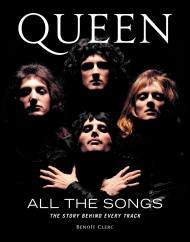Promotion
Use code BEST25 for 25% off storewide. Make sure to order by 11:59am, 12/12 for holiday delivery!
By clicking “Accept,” you agree to the use of cookies and similar technologies on your device as set forth in our Cookie Policy and our Privacy Policy. Please note that certain cookies are essential for this website to function properly and do not require user consent to be deployed.
All The Songs
The Story Behind Every Beatles Release
Contributors
Edited by Scott Freiman
Preface by Patti Smith
Formats and Prices
- On Sale
- Oct 22, 2013
- Page Count
- 672 pages
- Publisher
- Black Dog & Leventhal
- ISBN-13
- 9781579129521
Price
$55.00Price
$70.00 CADFormat
Format:
Hardcover $55.00 $70.00 CADThis item is a preorder. Your payment method will be charged immediately, and the product is expected to ship on or around October 22, 2013. This date is subject to change due to shipping delays beyond our control.
Buy from Other Retailers:
All the Songs delves deep into the history and origins of the Beatles and their music. This first-of-its-kind book draws upon decades of research, as music historians Margotin and Guesdon recount the circumstances that led to the composition of every song, the recording process, and the instruments used.
Here, we learn that one of John Lennon’s favorite guitars was a 1958 Rickenbacker 325 Capri, which he bought for £100 in 1960 in Hamburg, Germany. We also learn that “Love Me Do,” recorded in Abbey Road Studios in September 1962, took 18 takes to get right, even though it was one of the first songs John and Paul ever wrote together. The authors also reveal that when the Beatles performed “I Want to Hold Your Hand” on The Ed Sullivan Show in 1964, John’s microphone wasn’t turned on, so viewers only heard Paul singing.
There are hundreds of photographs throughout the book, including rare black-and-white publicity stills, images of the Beatles’ instruments, and engaging shots of the musicians at work in the recording studio.
All the Songs is the must-have book for the any true Beatles fan.
Series:
-
"Fun facts about every one of the Fab Four's creations, with photos. Yeah yeah yeah."People
-
"Fifty years ago, the Beatles released their debut album. ... if you're a fan and All the Songs: The Story Behind Every Beatles Release makes it onto your coffee table, chances are that it'll be the one least likely to leave. Music historians Jean-Michel Guesdon and Philippe Margotin dissect, discuss and analyze every song, from 'Please Please Me' (1963) to 'The Long and Winding Road' (1970). There's a well- written 'Genesis' and 'Production' section for each song, as well as enough technical tables to please everyone's inner nerd, not to mention 600 photographs.Wall Street Journal
-
"Everybody has a Beatles fan in their life, and you'll make them very happy if you give them a copy of All the Songs: The Story Behind Every Beatles Release."Newsday
-
"A perfect giftt for the Fab-Four fanatic."New York Post
-
"This is rock-solid stuff .... Yields all sorts of surprises, even for the initiated.... Essential for Beatles fans and a pleasure to read."Kirkus Reviews
-
"Beautiful layout and plenty of photos throughout.... And if that isn't enough, Patti Smith wrote the book's preface."A.V. Club, 'Our Favorite Books of the Year
-
"Impossible not to like for Beatle-types."The Nation
Newsletter Signup
By clicking ‘Sign Up,’ I acknowledge that I have read and agree to Hachette Book Group’s Privacy Policy and Terms of Use

















